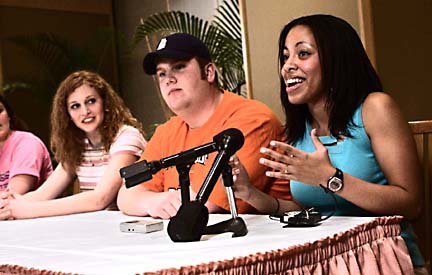
|
Ship survives
55-foot wave
Students recall their terrifying
encounter with a wall of water
south of the Aleutians
Becky Drury remembers a massive wave sweeping across her ship, right at the seventh deck, bouncing it back and forth, all the furnishings breaking loose.
"It was much like what they were showing on the tsunami," said Drury, an executive dean with the Semester at Sea Program, whose ship the Explorer limped into Honolulu Harbor yesterday after heavy seas disabled three of four of its engines.
The 55-foot wave was "a straight-up wall coming right at us. We saw numerous waves of that magnitude," she said. "It was such that you couldn't hold on."
The 591-foot Explorer, with 990 people aboard -- 681 students, 113 faculty and staff, and 196 crew members -- was about 650 miles south of Adak, Alaska, when the giant wave tossed the ship around in heavy seas, damaging engines and injuring two people.
Adak is in the Aleutian Islands about 1,300 miles southwest of Anchorage. The 100-day voyage began Jan. 18 in Vancouver. The Explorer was headed to Korea and Japan.
Students, teachers and school administrators slowly made their way through Customs yesterday after their ship docked at Pier 2 at about 3 p.m., and later talked about their experience at sea. The ship is expected to remain here for repairs and inspections, and the Coast Guard will decide if it is seaworthy to go on to China.
Semester at Sea is a University of Pittsburgh-based study-abroad program for undergraduate students intended to give students a more global perspective. Students from about 250 colleges are on board. Many of them are from the University of Pittsburgh and University of Colorado-Boulder.
Jim Barrero, general manager of V.Ships, which oversees technical operations, said, "It was a freak wave that hit that ship." The captain was aware of the rough weather, but 6,500 ships make the Pacific crossing annually, he said.
"I was terribly frightened," said Rhea Santangelo, who had not been worried at first since she had become accustomed to the rolling of the waves. Students and faculty were told to get out of their cabins and into the hallways.
TVs were flying, beds were being slammed across rooms and books were thrown from shelves, students reported.
When an announcement was made to go to the fifth floor, where the lifeboats are, Santangelo said, "I was on the verge of tears."
Many cried hysterically, she said.
At 11:30 p.m. Thursday, the night before the incident, they were warned by the bridge of high-velocity winds, said Kenn Gaither, assistant dean.
At 12:25 a.m. the chief engineer's window blew out, allowing a large amount of water to rush in and damage the console and equipment on the bridge, causing everything to go out, Drury said.
At 6 a.m. the captain decided to turn back out of the wind, and when he started the turn, a wave at least 55 feet high hit.
Two individuals were reportedly injured during the voyage and taken to a local hospital on arrival in Honolulu.
A spokesman said that the injuries were not serious.
[News] [Business] [Features] [Sports] [Editorial] [Do It Electric!]
[Classified Ads] [Search] [Subscribe] [Info] [Letter to Editor]
[Feedback]
